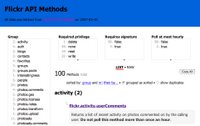 As it turns out, I had failed to notice that 48% of the API could be accessed without jumping through all those hoops. Thanks to a sudden flurry of JSONP activity from Henrik (I got to answer some question on it), I saw that he used APIs I had done hoop jumping to get at.
As it turns out, I had failed to notice that 48% of the API could be accessed without jumping through all those hoops. Thanks to a sudden flurry of JSONP activity from Henrik (I got to answer some question on it), I saw that he used APIs I had done hoop jumping to get at.It's amazing how much work it is to tell which Flickr methods are available unauthenticated. It should just be a click or two, or none at all and visible in an overview at the docs pages. I made the next best thing: a static Flickr API refdocs exhibit. So now you can. And you can browse the method call docstrings in a clickety manner without waiting for pages to load, either; all the documentation is loaded into one single place.
Just descriptions, privilege levels and so on, for now; for argument descriptions and the like, you'll still have to click the method to load the full page, but seeing as there is a neat reflection API in place, I might just make those loadable into the page, too, as another Exhibit and JSONP exercise.
That gets up to date documentation too, though I guess it might take a while to load, from doing 101 HTTP requests to pull in the data set as soon as you load the page. :)
Might be a good test about how Exhibit performs under such conditions too, though.